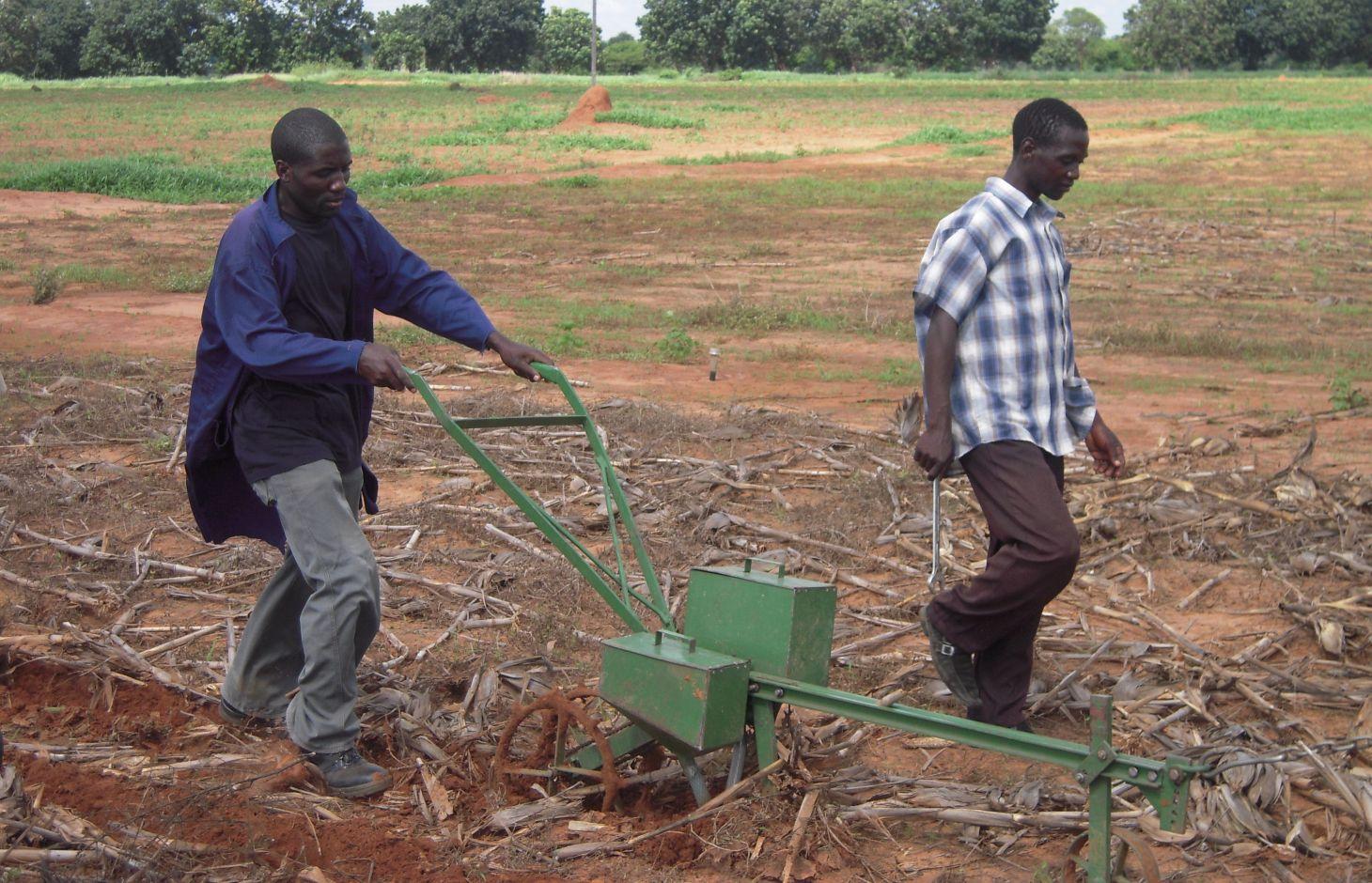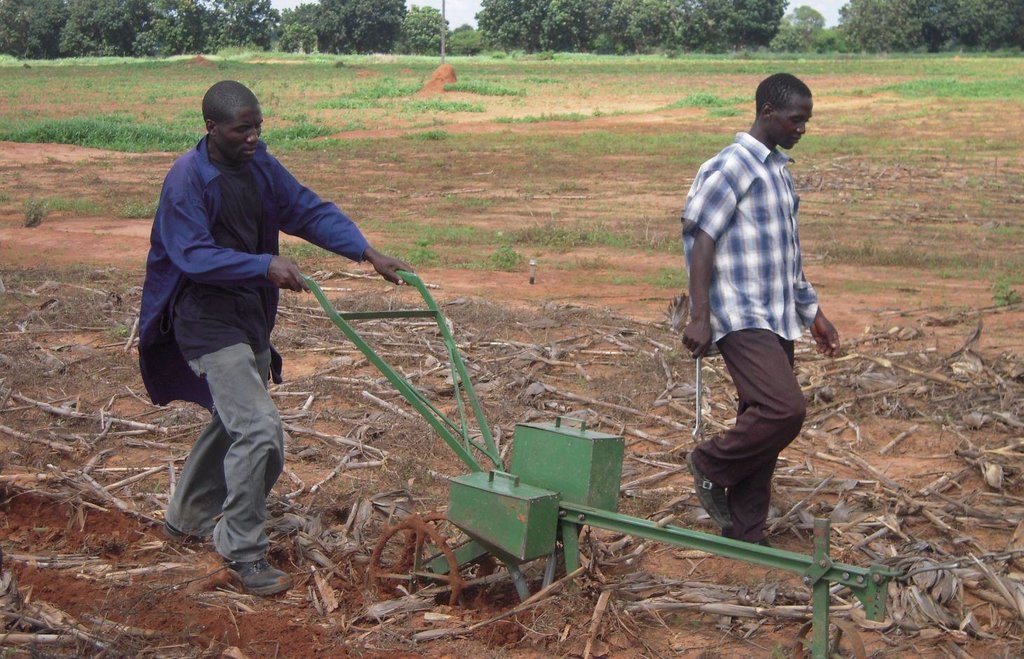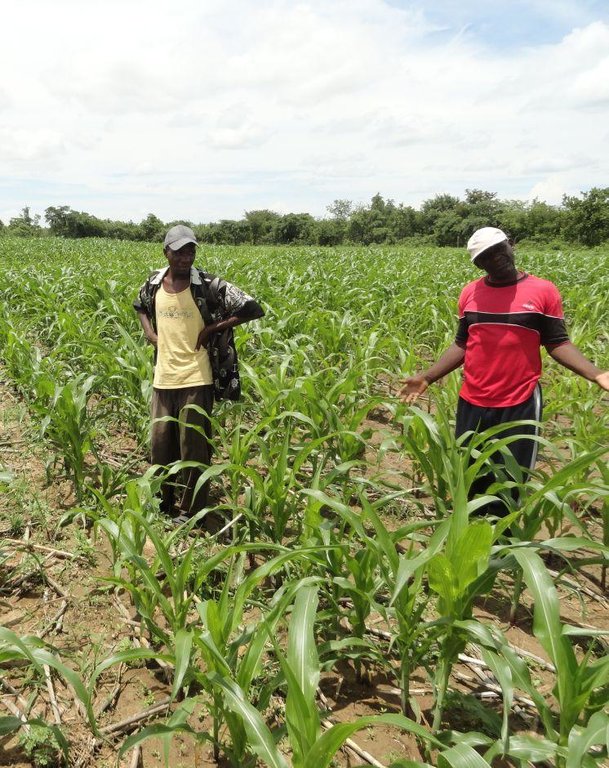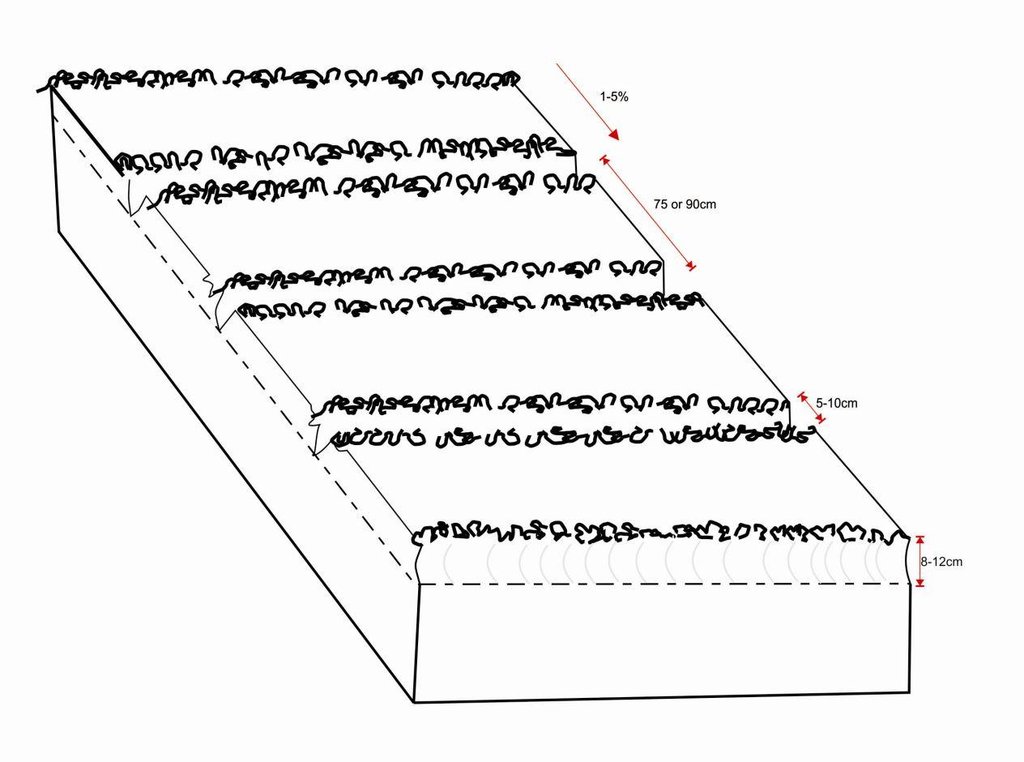Animal Draft Zero-Tillage [Zambie]
- Création :
- Mise à jour :
- Compilateur : Silenga Wamunyima
- Rédacteur : –
- Examinateurs : Alexandra Gavilano, Fabian Ottiger
Direct Planting
technologies_1140 - Zambie
Voir les sections
Développer tout Réduire tout1. Informations générales
1.2 Coordonnées des personnes-ressources et des institutions impliquées dans l'évaluation et la documentation de la Technologie
Spécialiste GDT:
Katoweji Alfred
Golden Valley Agricultural Research Trust
Zambie
Spécialiste GDT:
Ndandula Sharon
Golden Valley Agricultural Research Trust
Zambie
Nom du ou des institutions qui ont facilité la documentation/ l'évaluation de la Technologie (si pertinent)
Golden Valley agricultural research trust (Golden Valley agricultural research trust) - Zambie1.3 Conditions relatives à l'utilisation par WOCAT des données documentées
Quand les données ont-elles été compilées (sur le terrain)?
15/01/2013
Le compilateur et la(les) personne(s) ressource(s) acceptent les conditions relatives à l'utilisation par WOCAT des données documentées:
Oui
1.5 Référence au(x) questionnaire(s) sur les Approches de GDT
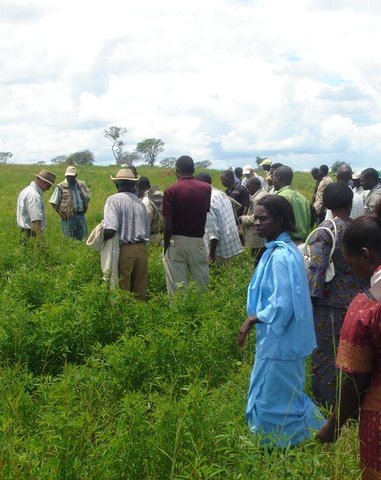
Participatory Research and Development [Zambie]
This is a collaborative process between researchers and farmers for developing and adapting new technologies that focus on incorporating the perspectives and inputs from the farmers into the development process.
- Compilateur : Arthur Chomba
2. Description de la Technologie de GDT
2.1 Courte description de la Technologie
Définition de la Technologie:
Animal draft zero-till involves the use of an animal drawn mechanical planter to plant directly in untilled soil to minimize soil disturbance and leave a cover of crop residues to conserve the soil and water.
2.2 Description détaillée de la Technologie
Description:
Zero-tillage takes advantage of the beneficial effects of biological processes to loosen the soil and to improve fertility. The organic matter from these processes aggregate the soil while the movement of soil organisms like worms and termites loosen the soil. This is called biological tillage and replaces mechanical tillage. The untilled soil surface covered by residues will require a planter specialized to plant in these conditions. In a sense, adopting zero-till does actually require a zero-till planter. The development of the strip-planter has made zero-till a viable option for animal draft farmers, which until now was not possible due to the unavailability or high cost of zero-till planters. The new planter is both cheap and easy to manufacture locally. The planter uses a narrow tine to open a planting furrow and seed/fertilizer is metered by vertically rotating plates. The planter is pulled by oxen and can plant rows of 75cm or 90cm rows with an intra-row which is determined by the seed plate used (3, 4, 5,…… seeds/m). The planting technology needs to be complemented with sound residue cover and weeding management practices.
Purpose of the Technology: The planter enables planting and fertilizing in untilled soil so that the soil residue cover and soil structure are preserved and can be used sustainably. The protective soil cover reduces evaporation and enhances infiltration while the improved soil structure and organic matter content increases soil water storage making zero tillage an important drought mitigating strategy. The immediate benefits of adopting zero-till are the possibility to plant a bigger area quickly and in time as well as the reduced soil erosion.
Establishment / maintenance activities and inputs: The first step in establishing zero-till is to assess the soil condition and levels of degradation. Where possible tests should be carried out but where not, the farmer needs to start on a small plot to check if there will be yield reduction from not tilling the soil. Where soils are severely degraded, an establishment phase should be embarked on where reduced tillage is practiced until the soil structure has recovered sufficiently to support crop growth without tillage. Liming acidic soils followed by a final ploughing will be required in the first year to correct the soil pH which otherwise will be difficult to correct once conservation tillage has been established. The organic matter levels need to be increased by increasing the amount of residues produced by the crop (i.e. the yields) and retaining these as soil cover. The next establishment activity is the purchase of the planter unit. Maintenance activities include planting and fertilizing in the same operation and weeding. Weeding will have to involve herbicide use to handle increased weed densities implying that spraying will become a major operation. In addition to the normal conventional inputs, herbicides will also become a major input and cost.
Natural / human environment: Zero-till has been applied in a wide range of bio-physical environments but mostly by the large scale farmers. The unavailability and high cost of specialized zero-till planter for small-scale farming has resulted in low adoption rates. The development of the Magoye Planter creates new opportunities for this practice. The farmer has to have sufficient knowledge to assess the soil condition and decide if is too degraded for zero-till or how long the transitional phase should be. Literacy is essential as the farmers will have to learn new approaches on weed control, pest control and crop rotations and adapt practices to suit his/her specific conditions.
2.3 Photos de la Technologie
2.5 Pays/ région/ lieux où la Technologie a été appliquée et qui sont couverts par cette évaluation
Pays:
Zambie
Région/ Etat/ Province:
Zambia/Southern Province
Autres spécifications du lieu:
Mazabuka/Magoye
Map
×2.6 Date de mise en œuvre de la Technologie
Si l'année précise est inconnue, indiquez la date approximative: :
- il y a moins de 10 ans (récemment)
2.7 Introduction de la Technologie
Spécifiez comment la Technologie a été introduite: :
- au cours d'expérimentations / de recherches
Commentaires (type de projet, etc.) :
Development of the Magoye planter began in 2008 in response to farmers’ feedback on the Magoye Ripper. Farmers started adopting the technology in 2011
3. Classification de la Technologie de GDT
3.2 Type(s) actuel(s) d'utilisation des terres, là où la Technologie est appliquée

Terres cultivées
- Cultures annuelles
Principales cultures (vivrières et commerciales):
Annual cropping is the main source of livelihood.

Pâturages
Pâturage extensif:
- Semi-nomadisme/ pastoralisme
Principales espèces animales et principaux produits:
Nearly half of the farmers own cattle but these are not sold regularly, only for school fees and ceremonies.
Livestock is grazing on crop residues
Commentaires:
Major land use problems (compiler’s opinion): Loss of soil structure and low soil fertility
Major land use problems (land users’ perception): Droughts and dry spell
3.3 Informations complémentaires sur l'utilisation des terres
Approvisionnement en eau des terres sur lesquelles est appliquée la Technologie:
- pluvial
Nombre de période de croissance par an: :
- 1
Précisez:
Longest growing period in days: 135Longest growing period from month to month: mid Nov to end of March
Densité d'élevage/ chargement (si pertinent):
1-10 LU /km2
3.5 Diffusion de la Technologie
Commentaires:
Total area covered by the SLM Technology is 0.56 m2.
Zero-Till with the Magoye planter technology was introduced in 2011 and is only in its second season of use. Only four farmers have adopted the technology although it has not yet been officially launched and promoted.
3.6 Mesures de GDT constituant la Technologie

pratiques agronomiques
- A2: Matière organique/ fertilité du sol
- A6: Autres
Commentaires:
Specification of other agronomic measures: Zero till, Crop residue
Type of agronomic measures: early planting, mulching, manure / compost / residues, mineral (inorganic) fertilizers, soil conditioners (lime, gypsum), zero tillage / no-till
3.7 Principaux types de dégradation des terres traités par la Technologie

érosion hydrique des sols
- Wt: perte de la couche superficielle des sols (couche arable)/ érosion de surface

dégradation chimique des sols
- Cn: baisse de la fertilité des sols et réduction du niveau de matière organique (non causée par l’érosion)

dégradation physique des sols
- Pk: scellage et encroûtement

dégradation biologique
- Bl: perte de la vie des sols
Commentaires:
Main causes of degradation: soil management (Overploughing, soil nutrient mining), crop management (annual, perennial, tree/shrub) (Monocropping), overgrazing (Overgrazing of crop residues), poverty / wealth (Charcoal burning, under application of fertilizer), inputs and infrastructure: (roads, markets, distribution of water points, other, …) (high cost of fertilizer)
Secondary causes of degradation: deforestation / removal of natural vegetation (incl. forest fires) (Charcoal burning), Heavy / extreme rainfall (intensity/amounts) (Overgrazing of crop residues), droughts, land tenure (Communal land overexploited), education, access to knowledge and support services (inadequate extension staff), governance / institutional (lack of credit facilities)
3.8 Prévention, réduction de la dégradation ou réhabilitation des terres dégradées
Spécifiez l'objectif de la Technologie au regard de la dégradation des terres:
- prévenir la dégradation des terres
- réduire la dégradation des terres
Commentaires:
Secondary goals: rehabilitation / reclamation of denuded land
4. Spécifications techniques, activités, intrants et coûts de mise en œuvre
4.1 Dessin technique de la Technologie
4.2 Spécification/ explications techniques du dessin technique
Planting lines are done at a depth of 8-12cm with inter row of 75 or 90cm. The width of the open furrow is 5-10cm wide. Planting rows are done across the slope to reduce runoff, these planting rows are done when the soil is moist during the rainy season and planting is done at the same time with land preparation. Farmers in Monze have combined ripping and zero till together. In the dry season they rip with the Magoye Ripper or GART Planter and later when the soil is moist use a zero till implement to plant.
Location: Magoye. Mazabuka/Southern Province/Zambia
Date: 2014-06-29
Technical knowledge required for field staff / advisors: high (This is a new technology and the extension staff must be able to help farmers troubleshoot and adapt the technology to local conditions.)
Technical knowledge required for land users: moderate (The farmers have to adopt new soil management practices, crop rotations and adapt the weeding approaches to complement the planting technology)
Main technical functions: improvement of surface structure (crusting, sealing), improvement of topsoil structure (compaction), increase of infiltration, increase / maintain water stored in soil
Secondary technical functions: control of raindrop splash, improvement of ground cover, improvement of subsoil structure (hardpan), increase in organic matter, increase in nutrient availability (supply, recycling,…), increase of groundwater level / recharge of groundwater, water harvesting / increase water supply, improvement of water quality, buffering / filtering water
Early planting
Material/ species: maize
Quantity/ density: 44,000 pla
Remarks: 25cm intra row by 75cm
Mulching
Material/ species: crop residues
Quantity/ density: 3ton/ha
Remarks: uniformly spread
Manure / compost / residues
Material/ species: crop residues
Quantity/ density: 3ton/ha
Remarks: uniformly spread
Mineral (inorganic) fertilizers
Material/ species: basal and top dressing
Quantity/ density: 400kg/ha
Remarks: spot application
Soil conditioners (lime, gypsum)
Material/ species: lime
Quantity/ density: 1ton/ha
Remarks: broadcast
4.3 Informations générales sur le calcul des intrants et des coûts
autre/ monnaie nationale (précisez):
Kwacha
Indiquer le taux de change du dollars en monnaie locale (si pertinent): 1 USD= :
5,0
Indiquez le coût salarial moyen de la main d'œuvre par jour:
2.40
4.4 Activités de mise en place/ d'établissement
| Activité | Type de mesures | Calendrier | |
|---|---|---|---|
| 1. | Purchase a magoye planter | Agronomique | |
| 2. | Purchase a knapsack sprayer | Agronomique |
Commentaires:
Life span of the magoye planter: 15 years
Life span of the knapsack sprayer: 5 years
4.5 Coûts et intrants nécessaires à la mise en place
| Spécifiez les intrants | Unité | Quantité | Coûts par unité | Coût total par intrant | % des coût supporté par les exploitants des terres | |
|---|---|---|---|---|---|---|
| Equipements | Magoye Planter | piece | 1,0 | 500,0 | 500,0 | 100,0 |
| Equipements | Knapsack sprayer | piece | 1,0 | 80,0 | 80,0 | 100,0 |
| Coût total de mise en place de la Technologie | 580,0 | |||||
Commentaires:
Duration of establishment phase: 2 month(s)
4.6 Activités d'entretien/ récurrentes
| Activité | Type de mesures | Calendrier/ fréquence | |
|---|---|---|---|
| 1. | Slashing, spreading residues | Agronomique | May-June every year after harvest |
| 2. | Liming | Agronomique | Nov - Dec every 3years |
| 3. | Planting and fertilizing | Agronomique | Nov-Dec at onset of rain |
| 4. | Chemical weeding | Agronomique | 3 times per growing season |
| 5. | Harvesting | Agronomique | May-June |
4.7 Coûts et intrants nécessaires aux activités d'entretien/ récurrentes (par an)
| Spécifiez les intrants | Unité | Quantité | Coûts par unité | Coût total par intrant | % des coût supporté par les exploitants des terres | |
|---|---|---|---|---|---|---|
| Main d'œuvre | Slashing, spreading residues | person days | 8,0 | 2,5 | 20,0 | 100,0 |
| Main d'œuvre | Liming | person days | 2,0 | 2,5 | 5,0 | 100,0 |
| Main d'œuvre | Chemical weeding | person days | 24,0 | 1,0 | 24,0 | 100,0 |
| Main d'œuvre | Harvesting | person days | 8,0 | 2,5 | 20,0 | 100,0 |
| Equipements | Animal traction for planting and fertilizing | ha | 1,0 | 40,0 | 40,0 | 100,0 |
| Matériel végétal | Seeds | kg | 20,0 | 2,5 | 50,0 | 100,0 |
| Matériel végétal | Fertilizer | kg | 400,0 | 0,8 | 320,0 | 100,0 |
| Matériel végétal | Herbicides | l | 5,0 | 6,0 | 30,0 | 100,0 |
| Matériel végétal | Lime | ton | 1,0 | 42,0 | 42,0 | 100,0 |
| Coût total d'entretien de la Technologie | 551,0 | |||||
Commentaires:
Machinery/ tools: The Magoye planter
Calculation are for 1ha of maize under strip tillage based conservation tillage and costs are for the Zambia situation in Magoye as of August 2012.
4.8 Facteurs les plus importants affectant les coûts
Décrivez les facteurs les plus importants affectant les coûts :
The weed control method is the main determinate factor depending on whether the farmer uses hand hoe or herbicides. Weed densities are higher in unploughed fields increasing the labour requirements/costs by a factor of about 5 if hand weeding is used instead of herbicides. Another major cost is that of fertilizer which makes up about half the cost hence the total cost will vary significantly depending on fertilizer cost.
5. Environnement naturel et humain
5.1 Climat
Précipitations annuelles
- < 250 mm
- 251-500 mm
- 501-750 mm
- 751-1000 mm
- 1001-1500 mm
- 1501-2000 mm
- 2001-3000 mm
- 3001-4000 mm
- > 4000 mm
Zone agro-climatique
- semi-aride
Thermal climate class: subtropics. 3 distinct seasons – summer, winter and one rainy season
5.2 Topographie
Pentes moyennes:
- plat (0-2 %)
- faible (3-5%)
- modéré (6-10%)
- onduleux (11-15%)
- vallonné (16-30%)
- raide (31-60%)
- très raide (>60%)
Reliefs:
- plateaux/ plaines
- crêtes
- flancs/ pentes de montagne
- flancs/ pentes de colline
- piémonts/ glacis (bas de pente)
- fonds de vallée/bas-fonds
Zones altitudinales:
- 0-100 m
- 101-500 m
- 501-1000 m
- 1001-1500 m
- 1501-2000 m
- 2001-2500 m
- 2501-3000 m
- 3001-4000 m
- > 4000 m
5.3 Sols
Profondeur moyenne du sol:
- très superficiel (0-20 cm)
- superficiel (21-50 cm)
- modérément profond (51-80 cm)
- profond (81-120 cm)
- très profond (>120 cm)
Texture du sol (de la couche arable):
- moyen (limoneux)
- fin/ lourd (argile)
Matière organique de la couche arable:
- faible (<1%)
5.4 Disponibilité et qualité de l'eau
Profondeur estimée de l’eau dans le sol:
> 50 m
Disponibilité de l’eau de surface:
moyenne
Qualité de l’eau (non traitée):
faiblement potable (traitement nécessaire)
5.6 Caractéristiques des exploitants des terres appliquant la Technologie
Revenus hors exploitation:
- 10-50% de tous les revenus
Niveau relatif de richesse:
- très pauvre
- pauvre
Individus ou groupes:
- individu/ ménage
Genre:
- hommes
Indiquez toute autre caractéristique pertinente des exploitants des terres:
Land users applying the Technology are mainly common / average land users
Difference in the involvement of women and men: The technology is applied mostly by men since most households are male headed and animal traction operation are reserved for men
Population density: 10-50 persons/km2
Annual population growth: 3% - 4%
8% of the land users are rich and own 15% of the land (own more than 10 cattle).
8% of the land users are average wealthy and own 15% of the land (own between 5 and 10 cattle).
16% of the land users are poor and own 20% of the land (own less than 5 cattle).
68% of the land users are poor and own 40% of the land (do not own cattle).
Off-farm income specification: sale of rainfed crops makes up about half of their income, the remainder coming from sale of livestock, petty trading, hiring out labour and remittances
Market orientation of production system: subsistence (self-supply), subsistence (self-supply), mixed (subsistence/ commercial
5.7 Superficie moyenne des terres détenues ou louées par les exploitants appliquant la Technologie
- < 0,5 ha
- 0,5-1 ha
- 1-2 ha
- 2-5 ha
- 5-15 ha
- 15-50 ha
- 50-100 ha
- 100-500 ha
- 500-1 000 ha
- 1 000-10 000 ha
- > 10 000 ha
Cette superficie est-elle considérée comme de petite, moyenne ou grande dimension (en se référant au contexte local)?
- petite dimension
Commentaires:
Average area of land owned or leased by land users applying the Technology: 1-2 ha, 2-5 ha, 5-15 ha, 5-15 ha, 15-50 ha, 15-50 ha, 50-100 ha
5.8 Propriété foncière, droits d’utilisation des terres et de l'eau
Propriété foncière:
- individu, sans titre de propriété
Droits d’utilisation des terres:
- accès libre (non organisé)
- individuel
- Land is apportioned by traditional leaders
Droits d’utilisation de l’eau:
- accès libre (non organisé)
- Land is apportioned by traditional leaders
5.9 Accès aux services et aux infrastructures
santé:
- pauvre
- modéré
- bonne
éducation:
- pauvre
- modéré
- bonne
assistance technique:
- pauvre
- modéré
- bonne
emploi (par ex. hors exploitation):
- pauvre
- modéré
- bonne
marchés:
- pauvre
- modéré
- bonne
énergie:
- pauvre
- modéré
- bonne
routes et transports:
- pauvre
- modéré
- bonne
eau potable et assainissement:
- pauvre
- modéré
- bonne
services financiers:
- pauvre
- modéré
- bonne
6. Impacts et conclusions
6.1 Impacts sur site que la Technologie a montrés
Impacts socio-économiques
Production
production agricole
production fourragère
risque d'échec de la production
surface de production
Quantité avant la GDT:
2-3ha
Quantité après la GDT:
>10
Revenus et coûts
revenus agricoles
diversité des sources de revenus
charge de travail
Impacts socioculturels
possibilités de loisirs
Impacts écologiques
Cycle de l'eau/ ruissellement
qualité de l'eau
récolte/ collecte de l'eau
ruissellement de surface
évaporation
Sols
humidité du sol
couverture du sol
perte en sol
encroûtement/ battance du sol
compaction du sol
cycle/ recharge des éléments nutritifs
salinité
matière organique du sol/ au dessous du sol C
Biodiversité: végétale, animale
biomasse/ au dessus du sol C
Réduction des risques de catastrophe et des risques climatiques
émissions de carbone et de gaz à effet de serre
6.2 Impacts hors site que la Technologie a montrés
disponibilité de l'eau
inondations en aval
pollution des rivières/ nappes phréatiques
dommages sur les champs voisins
6.3 Exposition et sensibilité de la Technologie aux changements progressifs et aux évènements extrêmes/catastrophes liés au climat (telles que perçues par les exploitants des terres)
Changements climatiques progressifs
Changements climatiques progressifs
| Saison | Type de changements/ extrêmes climatiques | Comment la Technologie fait-elle face à cela? | |
|---|---|---|---|
| températures annuelles | augmente | pas connu |
Extrêmes climatiques (catastrophes)
Catastrophes météorologiques
| Comment la Technologie fait-elle face à cela? | |
|---|---|
| pluie torrentielle locale | bien |
| tempête de vent locale | pas connu |
Catastrophes climatiques
| Comment la Technologie fait-elle face à cela? | |
|---|---|
| sécheresse | bien |
Catastrophes hydrologiques
| Comment la Technologie fait-elle face à cela? | |
|---|---|
| inondation générale (rivière) | pas bien |
Autres conséquences liées au climat
Autres conséquences liées au climat
| Comment la Technologie fait-elle face à cela? | |
|---|---|
| réduction de la période de croissance | bien |
6.4 Analyse coûts-bénéfices
Quels sont les bénéfices comparativement aux coûts de mise en place (du point de vue des exploitants des terres)?
Rentabilité à court terme:
positive
Rentabilité à long terme:
très positive
Quels sont les bénéfices comparativement aux coûts d'entretien récurrents (du point de vue des exploitants des terres)?
Rentabilité à court terme:
positive
Rentabilité à long terme:
très positive
Commentaires:
Timely and quicker planting enables larger areas to be planted and with less labour in the short term. Improved soil structure and soil fertility leads to higher yields and better resilience to droughts in the long term
6.5 Adoption de la Technologie
- cas isolés/ expérimentaux
Parmi tous ceux qui ont adopté la Technologie, combien d'entre eux l'ont fait spontanément, à savoir sans recevoir aucune incitation matérielle ou aucun paiement?
- 0-10%
Commentaires:
4 land user families have adopted the Technology without any external material support
Comments on spontaneous adoption: The Magoye planter has not yet been officially launched or promoted and the farmers currently using the technology heard of it by word of mouth and insisted on purchasing
There is a strong trend towards spontaneous adoption of the Technology
There has been numerous inquiries to purchase the Magoye planter even before it can be promoted
6.7 Points forts/ avantages/ possibilités de la Technologie
| Points forts/ avantages/ possibilités du point de vue de l'exploitant des terres |
|---|
|
Enables early planting How can they be sustained / enhanced? Plant in with the first rain |
|
Quicker planting enables the planting of larger areas How can they be sustained / enhanced? Plant the seed and fertilize in one operation |
|
reduced workload How can they be sustained / enhanced? Encourage minimum tillage |
| Points forts/ avantages/ possibilités du point de vue du compilateur ou d'une autre personne ressource clé |
|---|
|
Enables early planting How can they be sustained / enhanced? Plant in November with the first heavy rain |
|
Quicker planting enables the planting of larger areas How can they be sustained / enhanced? Use herbicides because without them, the capacity to weed will limit the production capacity |
|
Preserves soil cover and reduces soil disturbance How can they be sustained / enhanced? Training in residue management and zero till |
6.8 Faiblesses/ inconvénients/ risques de la Technologie et moyens de les surmonter
| Faiblesses/ inconvénients/ risques du point de vue de l’exploitant des terres | Comment peuvent-ils être surmontés? |
|---|---|
| The purchase price of the Magoye planter is quite high | Subsidize the implement |
| Excessive weeds and lack of information on herbicide use | More training on herbicide use |
| Faiblesses/ inconvénients/ risques du point de vue du compilateur ou d'une autre personne ressource clé | Comment peuvent-ils être surmontés? |
|---|---|
| The purchase price for the planter is on the higher side making it affordable only to the larger small-scale farmers | the price is likely to go down when the planter is mass produced |
| difficult to control weeds in the absence of herbicides | use herbicides |
7. Références et liens
7.2 Références des publications disponibles
Titre, auteur, année, ISBN:
Social-economic analysis of conservation agriculture in southern Africa, FAO, 2011
Disponible à partir d'où? Coût?
FAO
Titre, auteur, année, ISBN:
Conservation farming in Zambia, Steven Haggblade, Gelson Tembo, October 2003
Disponible à partir d'où? Coût?
Indaba project, Michigan state university
Titre, auteur, année, ISBN:
Conservation farming in Zambia, Conservation farming unit (CFU), 2011
Disponible à partir d'où? Coût?
cfu@zamnet.zm
Liens et modules
Développer tout Réduire toutLiens

Participatory Research and Development [Zambie]
This is a collaborative process between researchers and farmers for developing and adapting new technologies that focus on incorporating the perspectives and inputs from the farmers into the development process.
- Compilateur : Arthur Chomba
Modules
Aucun module trouvé


